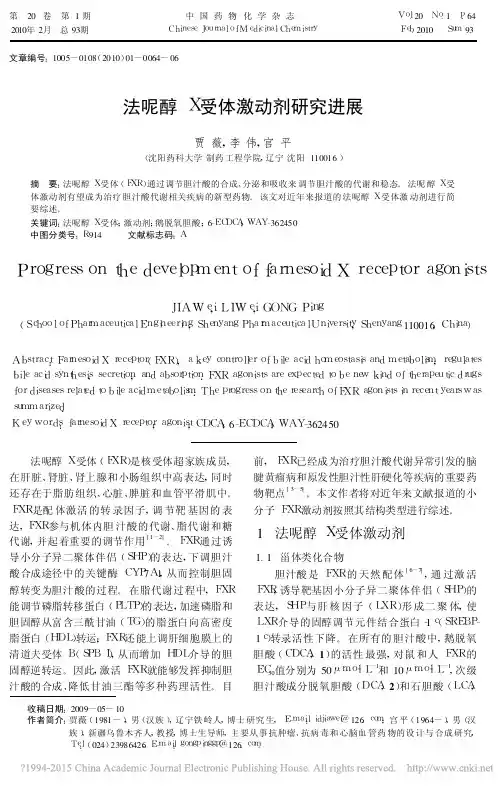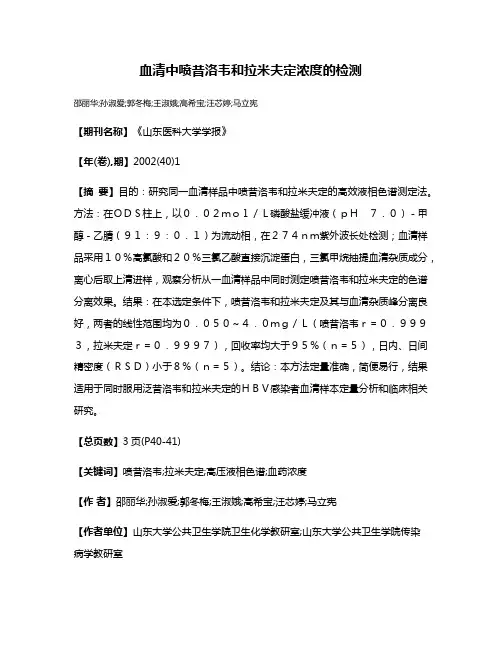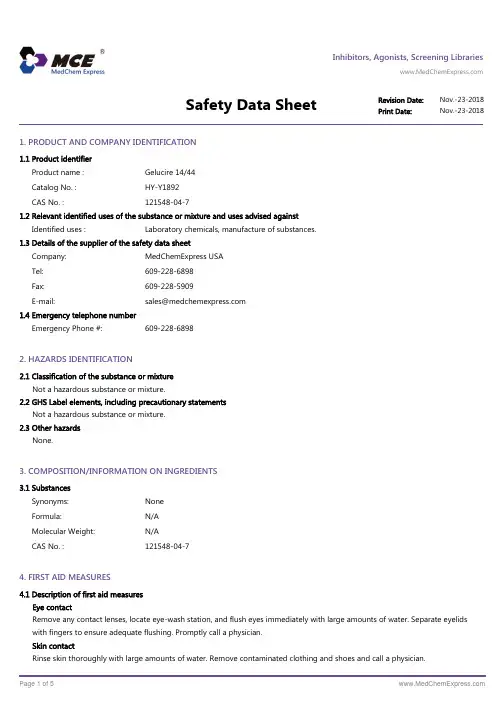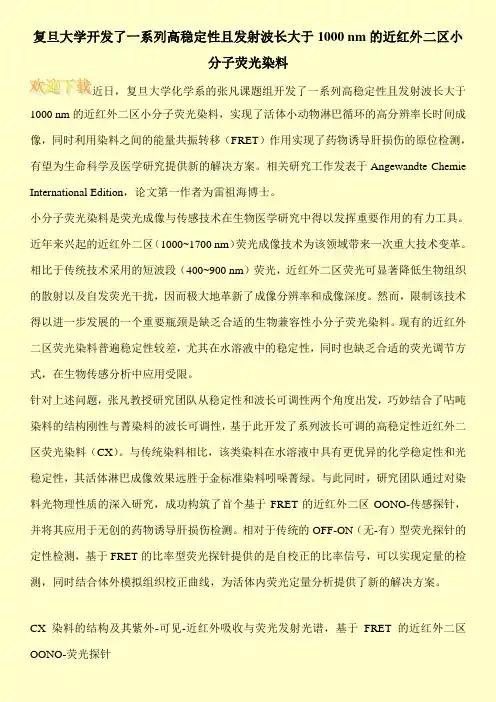CCF642_SDS_MedChemExpress
一种新型激酶抑制剂的制备及其应用[发明专利]
![一种新型激酶抑制剂的制备及其应用[发明专利]](https://uimg.taocdn.com/27a07cc70066f5335b812165.webp)
专利名称:一种新型激酶抑制剂的制备及其应用
专利类型:发明专利
发明人:刘磊,程鹏,耿美玉,曹文杰,江磊,艾菁,黄敏,杨新颖,查传涛,曹建华,陈春麟,丁健
申请号:CN201510279568.6
申请日:20150527
公开号:CN106279119A
公开日:
20170104
专利内容由知识产权出版社提供
摘要:本发明公开了一种新型激酶抑制剂的制备及其应用。
具体地,本发明提供了一种如下式I所示的化合物;其中,各基团的定义如说明书中所述。
本发明的化合物具有很好的FGFR激酶抑制活性,可以用于制备一系列治疗FGFR激酶活性相关的疾病的药物。
申请人:上海海和药物研究开发有限公司,中国科学院上海药物研究所
地址:201203 上海市浦东新区张江高科技园区牛顿路421号
国籍:CN
代理机构:上海一平知识产权代理有限公司
更多信息请下载全文后查看。
法呢醇X受体激动剂研究进展_贾薇

收稿日期:2009-05-10作者简介:贾薇(1981-),男(汉族),辽宁铁岭人,博士研究生,E -m a i l :i d j i a w e i @126.c o m ;宫平(1964-),男(汉族),新疆乌鲁木齐人,教授,博士生导师,主要从事抗肿瘤、抗病毒和心脑血管药物的设计与合成研究,T e l :(024)23986426,E -m a i l :g o n g p i n g g p @126.c o m 。
文章编号:1005-0108(2010)01-0064-06法呢醇X 受体激动剂研究进展贾薇,李伟,宫平(沈阳药科大学制药工程学院,辽宁沈阳110016)摘 要:法呢醇X 受体(F X R )通过调节胆汁酸的合成、分泌和吸收来调节胆汁酸的代谢和稳态。
法呢醇X 受体激动剂有望成为治疗胆汁酸代谢相关疾病的新型药物。
该文对近年来报道的法呢醇X 受体激动剂进行简要综述。
关键词:法呢醇X 受体;激动剂;鹅脱氧胆酸;6-E C D C A ;W A Y -362450中图分类号:R 914 文献标志码:AP r o g r e s s o nt h e d e v e l o p m e n t o f f a r n e s o i dXr e c e p t o r a g o n i s t sJ I AWe i ,L I We i ,G O N GP i n g(S c h o o l o f P h a r m a c e u t i c a l E n g i n e e r i n g ,S h e n y a n g P h a r m a c e u t i c a l U n i v e r s i t y ,S h e n y a n g 110016,C h i n a )A b s t r a c t :F a r n e s o i d Xr e c e p t o r (F X R ),a k e yc o n t r o l l e r o f b i l e a c i d h o m e o s t a s i s a n dm e t a b o l i s m ,r e g u l a t e s b i l e a c i d s y n t h e s i s ,s e c r e t i o n ,a n d a b s o r p t i o n .F X Ra g o n i s t s a r e e x p e c t e d t o b e n e wk i n d o f t h e r a p e u t i c d r u g s f o r d i s e a s e s r e l a t e d t o b i l e a c i d m e t a b o l i s m .T h e p r o g r e s s o n t h e r e s e a r c h o f F X Ra g o n i s t s i n r e c e n t y e a r s w a s s u m m a r i z e d .K e y w o r d s :f a r n e s o i d Xr e c e p t o r ;a g o n i s t ;C D C A ;6-E C D C A ;W A Y -362450 法呢醇X 受体(F X R )是核受体超家族成员,在肝脏、肾脏、肾上腺和小肠组织中高表达,同时还存在于脂肪组织、心脏、脾脏和血管平滑肌中。
血清中喷昔洛韦和拉米夫定浓度的检测

血清中喷昔洛韦和拉米夫定浓度的检测邵丽华;孙淑爱;郭冬梅;王淑娥;高希宝;汪芯婷;马立宪【期刊名称】《山东医科大学学报》【年(卷),期】2002(40)1【摘要】目的:研究同一血清样品中喷昔洛韦和拉米夫定的高效液相色谱测定法。
方法:在ODS柱上,以0.02mol/L磷酸盐缓冲液(pH7.0)-甲醇-乙腈(91:9:0.1)为流动相,在274nm紫外波长处检测;血清样品采用10%高氯酸和20%三氯乙酸直接沉淀蛋白,三氯甲烷抽提血清杂质成分,离心后取上清进样,观察分析从一血清样品中同时测定喷昔洛韦和拉米夫定的色谱分离效果。
结果:在本选定条件下,喷昔洛韦和拉米夫定及其与血清杂质峰分离良好,两者的线性范围均为0.050~4.0mg/L(喷昔洛韦r=0.9993,拉米夫定r=0.9997),回收率均大于95%(n=5),日内、日间精密度(RSD)小于8%(n=5)。
结论:本方法定量准确,简便易行,结果适用于同时服用泛昔洛韦和拉米夫定的HBV感染者血清样本定量分析和临床相关研究。
【总页数】3页(P40-41)【关键词】喷昔洛韦;拉米夫定;高压液相色谱;血药浓度【作者】邵丽华;孙淑爱;郭冬梅;王淑娥;高希宝;汪芯婷;马立宪【作者单位】山东大学公共卫生学院卫生化学教研室;山东大学公共卫生学院传染病学教研室【正文语种】中文【中图分类】R978.7;R969.1【相关文献】1.高效液相色谱-紫外检测梯度洗脱法快速检测人血清中帕罗西汀及舍曲林的药物浓度 [J], 孙秀佳;林治光;任娟娟;崔慧茹;蒋平;刘红梅;姜丽娟;李春波2.RP-HPLC法测定小鼠血清及脏器中拉米夫定的浓度 [J], 薛克昌;顾宜;张三奇;蒋永培3.定量检测人血清中可溶性PD-L1蛋白浓度的方法开发及验证 [J], 高恩惠;张瑞霞;黄应峰;满素勤;程远国因版权原因,仅展示原文概要,查看原文内容请购买。
Gelucire-14-44-SDS-MedChemExpress

Inhibitors, Agonists, Screening LibrariesSafety Data Sheet Revision Date:Nov.-23-2018Print Date:Nov.-23-20181. PRODUCT AND COMPANY IDENTIFICATION1.1 Product identifierProduct name :Gelucire 14/44Catalog No. :HY-Y1892CAS No. :121548-04-71.2 Relevant identified uses of the substance or mixture and uses advised againstIdentified uses :Laboratory chemicals, manufacture of substances.1.3 Details of the supplier of the safety data sheetCompany:MedChemExpress USATel:609-228-6898Fax:609-228-5909E-mail:sales@1.4 Emergency telephone numberEmergency Phone #:609-228-68982. HAZARDS IDENTIFICATION2.1 Classification of the substance or mixtureNot a hazardous substance or mixture.2.2 GHS Label elements, including precautionary statementsNot a hazardous substance or mixture.2.3 Other hazardsNone.3. COMPOSITION/INFORMATION ON INGREDIENTS3.1 SubstancesSynonyms:NoneFormula:N/AMolecular Weight:N/ACAS No. :121548-04-74. FIRST AID MEASURES4.1 Description of first aid measuresEye contactRemove any contact lenses, locate eye-wash station, and flush eyes immediately with large amounts of water. Separate eyelids with fingers to ensure adequate flushing. Promptly call a physician.Skin contactRinse skin thoroughly with large amounts of water. Remove contaminated clothing and shoes and call a physician.InhalationImmediately relocate self or casualty to fresh air. If breathing is difficult, give cardiopulmonary resuscitation (CPR). Avoid mouth-to-mouth resuscitation.IngestionWash out mouth with water; Do NOT induce vomiting; call a physician.4.2 Most important symptoms and effects, both acute and delayedThe most important known symptoms and effects are described in the labelling (see section 2.2).4.3 Indication of any immediate medical attention and special treatment neededTreat symptomatically.5. FIRE FIGHTING MEASURES5.1 Extinguishing mediaSuitable extinguishing mediaUse water spray, dry chemical, foam, and carbon dioxide fire extinguisher.5.2 Special hazards arising from the substance or mixtureDuring combustion, may emit irritant fumes.5.3 Advice for firefightersWear self-contained breathing apparatus and protective clothing.6. ACCIDENTAL RELEASE MEASURES6.1 Personal precautions, protective equipment and emergency proceduresUse full personal protective equipment. Avoid breathing vapors, mist, dust or gas. Ensure adequate ventilation. Evacuate personnel to safe areas.Refer to protective measures listed in sections 8.6.2 Environmental precautionsTry to prevent further leakage or spillage. Keep the product away from drains or water courses.6.3 Methods and materials for containment and cleaning upAbsorb solutions with finely-powdered liquid-binding material (diatomite, universal binders); Decontaminate surfaces and equipment by scrubbing with alcohol; Dispose of contaminated material according to Section 13.7. HANDLING AND STORAGE7.1 Precautions for safe handlingAvoid inhalation, contact with eyes and skin. Avoid dust and aerosol formation. Use only in areas with appropriate exhaust ventilation.7.2 Conditions for safe storage, including any incompatibilitiesKeep container tightly sealed in cool, well-ventilated area. Keep away from direct sunlight and sources of ignition.Recommended storage temperature:Pure form-20°C 3 years4°C 2 yearsIn solvent-80°C 6 months-20°C 1 monthShipping at room temperature if less than 2 weeks.7.3 Specific end use(s)No data available.8. EXPOSURE CONTROLS/PERSONAL PROTECTION8.1 Control parametersComponents with workplace control parametersThis product contains no substances with occupational exposure limit values.8.2 Exposure controlsEngineering controlsEnsure adequate ventilation. Provide accessible safety shower and eye wash station.Personal protective equipmentEye protection Safety goggles with side-shields.Hand protection Protective gloves.Skin and body protection Impervious clothing.Respiratory protection Suitable respirator.Environmental exposure controls Keep the product away from drains, water courses or the soil. Cleanspillages in a safe way as soon as possible.9. PHYSICAL AND CHEMICAL PROPERTIES9.1 Information on basic physical and chemical propertiesAppearance White to off-white (Oil)Odor No data availableOdor threshold No data availablepH No data availableMelting/freezing point No data availableBoiling point/range No data availableFlash point No data availableEvaporation rate No data availableFlammability (solid, gas)No data availableUpper/lower flammability or explosive limits No data availableVapor pressure No data availableVapor density No data availableRelative density No data availableWater Solubility No data availablePartition coefficient No data availableAuto-ignition temperature No data availableDecomposition temperature No data availableViscosity No data availableExplosive properties No data availableOxidizing properties No data available9.2 Other safety informationNo data available.10. STABILITY AND REACTIVITY10.1 ReactivityNo data available.10.2 Chemical stabilityStable under recommended storage conditions.10.3 Possibility of hazardous reactionsNo data available.10.4 Conditions to avoidNo data available.10.5 Incompatible materialsStrong acids/alkalis, strong oxidising/reducing agents.10.6 Hazardous decomposition productsUnder fire conditions, may decompose and emit toxic fumes.Other decomposition products - no data available.11.TOXICOLOGICAL INFORMATION11.1 Information on toxicological effectsAcute toxicityClassified based on available data. For more details, see section 2Skin corrosion/irritationClassified based on available data. For more details, see section 2Serious eye damage/irritationClassified based on available data. For more details, see section 2Respiratory or skin sensitizationClassified based on available data. For more details, see section 2Germ cell mutagenicityClassified based on available data. For more details, see section 2CarcinogenicityIARC: No component of this product present at a level equal to or greater than 0.1% is identified as probable, possible or confirmed human carcinogen by IARC.ACGIH: No component of this product present at a level equal to or greater than 0.1% is identified as a potential or confirmed carcinogen by ACGIH.NTP: No component of this product present at a level equal to or greater than 0.1% is identified as a anticipated or confirmed carcinogen by NTP.OSHA: No component of this product present at a level equal to or greater than 0.1% is identified as a potential or confirmed carcinogen by OSHA.Reproductive toxicityClassified based on available data. For more details, see section 2Specific target organ toxicity - single exposureClassified based on available data. For more details, see section 2Specific target organ toxicity - repeated exposureClassified based on available data. For more details, see section 2Aspiration hazardClassified based on available data. For more details, see section 212. ECOLOGICAL INFORMATION12.1 ToxicityNo data available.12.2 Persistence and degradabilityNo data available.12.3 Bioaccumlative potentialNo data available.12.4 Mobility in soilNo data available.12.5 Results of PBT and vPvB assessmentPBT/vPvB assessment unavailable as chemical safety assessment not required or not conducted.12.6 Other adverse effectsNo data available.13. DISPOSAL CONSIDERATIONS13.1 Waste treatment methodsProductDispose substance in accordance with prevailing country, federal, state and local regulations.Contaminated packagingConduct recycling or disposal in accordance with prevailing country, federal, state and local regulations.14. TRANSPORT INFORMATIONDOT (US)This substance is considered to be non-hazardous for transport.IMDGThis substance is considered to be non-hazardous for transport.IATAThis substance is considered to be non-hazardous for transport.15. REGULATORY INFORMATIONSARA 302 Components:No chemicals in this material are subject to the reporting requirements of SARA Title III, Section 302.SARA 313 Components:This material does not contain any chemical components with known CAS numbers that exceed the threshold (De Minimis) reporting levels established by SARA Title III, Section 313.SARA 311/312 Hazards:No SARA Hazards.Massachusetts Right To Know Components:No components are subject to the Massachusetts Right to Know Act.Pennsylvania Right To Know Components:No components are subject to the Pennsylvania Right to Know Act.New Jersey Right To Know Components:No components are subject to the New Jersey Right to Know Act.California Prop. 65 Components:This product does not contain any chemicals known to State of California to cause cancer, birth defects, or anyother reproductive harm.16. OTHER INFORMATIONCopyright 2018 MedChemExpress. The above information is correct to the best of our present knowledge but does not purport to be all inclusive and should be used only as a guide. The product is for research use only and for experienced personnel. It must only be handled by suitably qualified experienced scientists in appropriately equipped and authorized facilities. The burden of safe use of this material rests entirely with the user. MedChemExpress disclaims all liability for any damage resulting from handling or from contact with this product.Caution: Product has not been fully validated for medical applications. For research use only.Tel: 609-228-6898 Fax: 609-228-5909 E-mail: tech@Address: 1 Deer Park Dr, Suite Q, Monmouth Junction, NJ 08852, USA。
一株铵离子耐受型产丁二酸的大肠杆菌及其应用[发明专利]
![一株铵离子耐受型产丁二酸的大肠杆菌及其应用[发明专利]](https://uimg.taocdn.com/9c6c9ff9c5da50e2534d7f27.webp)
专利名称:一株铵离子耐受型产丁二酸的大肠杆菌及其应用专利类型:发明专利
发明人:姜岷,管钊,马江锋,吴明科,陈吴方,陈美丽
申请号:CN201510280199.2
申请日:20150527
公开号:CN104877941A
公开日:
20150902
专利内容由知识产权出版社提供
摘要:本发明公开了一株铵离子耐受型产丁二酸大肠杆菌及其应用,其属于埃希氏菌属,命名为大肠埃希氏菌BER528(Escherichia coli)BER528,其保藏编号为CCTCC NO:M2015160。
本发明还公开了上述大肠杆菌在丁二酸发酵生产中的应用。
本发明的菌株可以在厌氧条件下,耐受高浓度的铵离子,并积累丁二酸。
在外源添加0.53mol/LNH的厌氧摇瓶发酵中,72h菌体DCW为
1.82g/L,丁二酸产量为11.72g/L,而原始出发菌株在该条件生长极其缓慢,72h菌体DCW仅为1.14g/L,丁二酸产量为
2.56g/L。
相对于出发菌株,丁二酸产量提高4.57倍。
在5L发酵罐中利用氨水调节pH厌氧发酵过程中,厌氧发酵90h,突变株的DCW和最终的丁二酸产量分别为1.22g/L和27.32g/L,分别是出发菌株的1.16倍和1.88倍,因此该突变株BER528具有重大的社会意义和经济价值。
申请人:南京工业大学
地址:211816 江苏省南京市浦口区浦珠南路30号南京工业大学生工楼A座601
国籍:CN
代理机构:江苏致邦律师事务所
代理人:徐蓓
更多信息请下载全文后查看。
复旦大学开发了一系列高稳定性且发射波长大于1000 nm的近红外二区小分子荧光染料

复旦大学开发了一系列高稳定性且发射波长大于1000 nm的近红外二区小分子荧光染料近日,复旦大学化学系的张凡课题组开发了一系列高稳定性且发射波长大于1000 nm的近红外二区小分子荧光染料,实现了活体小动物淋巴循环的高分辨率长时间成像,同时利用染料之间的能量共振转移(FRET)作用实现了药物诱导肝损伤的原位检测,有望为生命科学及医学研究提供新的解决方案。
相关研究工作发表于Angewandte Chemie International Edition,论文第一作者为雷祖海博士。
小分子荧光染料是荧光成像与传感技术在生物医学研究中得以发挥重要作用的有力工具。
近年来兴起的近红外二区(1000~1700 nm)荧光成像技术为该领域带来一次重大技术变革。
相比于传统技术采用的短波段(400~900 nm)荧光,近红外二区荧光可显著降低生物组织的散射以及自发荧光干扰,因而极大地革新了成像分辨率和成像深度。
然而,限制该技术得以进一步发展的一个重要瓶颈是缺乏合适的生物兼容性小分子荧光染料。
现有的近红外二区荧光染料普遍稳定性较差,尤其在水溶液中的稳定性,同时也缺乏合适的荧光调节方式,在生物传感分析中应用受限。
针对上述问题,张凡教授研究团队从稳定性和波长可调性两个角度出发,巧妙结合了呫吨染料的结构刚性与菁染料的波长可调性,基于此开发了系列波长可调的高稳定性近红外二区荧光染料(CX)。
与传统染料相比,该类染料在水溶液中具有更优异的化学稳定性和光稳定性,其活体淋巴成像效果远胜于金标准染料吲哚菁绿。
与此同时,研究团队通过对染料光物理性质的深入研究,成功构筑了首个基于FRET的近红外二区OONO-传感探针,并将其应用于无创的药物诱导肝损伤检测。
相对于传统的OFF-ON(无-有)型荧光探针的定性检测,基于FRET的比率型荧光探针提供的是自校正的比率信号,可以实现定量的检测,同时结合体外模拟组织校正曲线,为活体内荧光定量分析提供了新的解决方案。
紫薯花青素抗结肠癌作用及其诱导细胞凋亡机制
紫薯花青素抗结肠癌作用及其诱导细胞凋亡机制陈伟莉;张晨;张旭浩;刘冬影;赵玺【期刊名称】《吉林大学学报(医学版)》【年(卷),期】2015(041)004【摘要】目的:探讨紫薯中原花青素(PCI)对人结肠癌细胞(HCT-116)的细胞毒性作用,阐明其诱导细胞凋亡的机制.方法:取处于对数生长期HCT-116细胞和人成纤维细胞HF-91随机分为对照组(PBS组)、阳性药组[25 mg· L-1顺铂(DDP)]和PCI 组(终浓度分别为25、50和100 mg·L-1).采用CCK8法检测细胞增殖抑制率,AO/EB法荧光显微镜观察细胞凋亡情况,流式细胞术检测JC-1线粒体膜电位变化,qPCR法检测p53和caspase-3 mRNA表达水平.结果:与DDP组比较,100 mg·L-1 PCI组HCT-116细胞增殖抑制率明显升高(P<0.05),各浓度PCI组HF-91细胞增殖抑制率明显降低(P<0.05),且呈浓度依赖性.与DDP组比较,50和100 mg·L-1 PCI组HCT-116细胞凋亡率明显升高(P<0.05).与对照组比较,DDP组和不同浓度PCI组HCT-116细胞中caspase-3和p53 mRNA表达水平均明显升高(P<0.05);与DDP组比较,不同浓度PCI组HCT-116细胞中caspase-3 mRNA表达水平均明显升高(P<0.05),100mg·L-1 PCI组HCT-116细胞中p53 mRNA表达水平明显升高(P<0.05),且呈浓度依赖性.结论:紫薯花青素对消化系统肿瘤细胞具有较强的毒性作用,而对正常细胞毒性较小.【总页数】6页(P785-789,后插5)【作者】陈伟莉;张晨;张旭浩;刘冬影;赵玺【作者单位】黑河学院理学院生物系,黑龙江黑河164300;吉林大学药学院再生医学系,吉林长春130021;吉林大学第一医院转化医学院,吉林长春130021;黑河学院理学院生物系,黑龙江黑河164300;黑河学院理学院生物系,黑龙江黑河164300【正文语种】中文【中图分类】R735.3【相关文献】1.紫薯花青素体外抗氧化及对H2O2诱导HepG2细胞氧化损伤的保护作用 [J], 罗春丽;王林;李杏;张子程;张久亮2.熊猫豆提取物抑制肿瘤活性及诱导结肠癌细胞Caco-2凋亡机制研究 [J], 胡冬梅;彭吕杨;薛照辉3.食欲素诱导结肠癌细胞凋亡机制的研究 [J], 张蓉;苏文涛;安楠;刘君;藤启凤;李兴梅;白飞虎;呼圣娟4.紫薯花青素对油酸诱导HepG2细胞血脂代谢的影响 [J], 石慧5.结肠癌细胞裂解物致敏的树突状细胞-细胞因子诱导杀伤细胞抗自体结肠癌细胞效应研究 [J], 朱克祥;王锦明;袁得峰;张正聪;吕鹏飞;白小平;李汛;潘藤因版权原因,仅展示原文概要,查看原文内容请购买。
鼻咽癌原代培养细胞分泌性蛋白图谱的初步研究
鼻咽癌原代培养细胞分泌性蛋白图谱的初步研究葛圣雷;朱纲华;陈主初;谢鼎华【期刊名称】《现代生物医学进展》【年(卷),期】2007(007)008【摘要】目的:建立细胞分泌性蛋白的蛋白质组学研究方法,在此基础上初步建立鼻咽癌细胞分泌蛋白图谱.方法:通过组织块法进行鼻咽癌细胞原代培养,收集细胞上清,超滤法脱盐并浓缩上清蛋白质,双向凝胶电泳技术建立细胞分泌性蛋白图谱.结果:鼻咽癌细胞原代培养取得成功,并初步建立了鼻咽癌细胞分泌性蛋白的双向凝胶电泳图谱.结论:建立了细胞分泌性蛋白的蛋白质组学研究方法,开展了鼻咽癌细胞分泌组学研究,为阐述鼻咽癌癌变机制提供了依据,也为后续研究打下了坚实的实验基础.【总页数】3页(P1200-1201,1204)【作者】葛圣雷;朱纲华;陈主初;谢鼎华【作者单位】中南大学湘雅二医院耳鼻咽喉头颈外科,湖南,长沙,410011;中南大学湘雅二医院耳鼻咽喉头颈外科,湖南,长沙,410011;中南大学湘雅二医院耳鼻咽喉头颈外科,湖南,长沙,410011;中南大学湘雅二医院耳鼻咽喉头颈外科,湖南,长沙,410011【正文语种】中文【中图分类】R739.6【相关文献】1.不同中医临床证型下行型鼻咽癌组织细胞核蛋白质差异表达的初步研究 [J], 何迎春;刘宇勤;廖端芳;戴娜;何兰;范婧莹;田道法2.免疫球蛋白kappa轻链基因在鼻咽癌中表达的初步研究 [J], 廖伟;曹亚;夏林庆3.鼻咽癌组织中β-连环蛋白基因表达水平的初步研究 [J], 贾峻嵩;邓星;尤长宣4.人乳头瘤病毒阳性阴道分泌物蛋白指纹图谱初步研究 [J], 姜伟;解春宝;杜琼;黄文芳;杨永长;肖代雯5.鼻咽癌HNE1细胞与CNE1细胞的蛋白质表达谱的初步研究 [J], 吴尚辉;彭聪;黄柏英;罗学滨;祝斌因版权原因,仅展示原文概要,查看原文内容请购买。
一种海葵神经毒素基因及其应用[发明专利]
专利名称:一种海葵神经毒素基因及其应用
专利类型:发明专利
发明人:徐安龙,刘文华,彭文烈,王义良,彭立胜,卫剑文,王磊申请号:CN02114743.4
申请日:20020116
公开号:CN1432651A
公开日:
20030730
专利内容由知识产权出版社提供
摘要:本发明公开了一种新的一种海葵神经毒素基因hk30,它是用RT-PCR的方法,从侧花海葵触手总RNA中分离得到的,其序列长度为141bp。
本发明获得的重组海葵神经毒素具有生物活性,对大鼠离体心房具有强烈的促进收缩作用。
本发明还公开了上述基因的表达及在制备治疗心血管疾病药物中的应用。
申请人:中山大学
地址:510275 广东省广州市新港西路135号
国籍:CN
代理机构:广州粤高专利代理有限公司
代理人:陈卫
更多信息请下载全文后查看。
上海交大关于硒的研究
上海交大关于硒的研究
上海交通大学在硒的研究方面取得了一些进展。
2021年8月19日,昆士兰大学/上海交通大学余迪,华中科技大学刘争及复旦大学张文宏等人在Nature Immunology 在线发表题为“Selenium–GPX4 axis protects follicular helper T cells from ferroptosis”的研究论文,该研究报告了 TFH 细胞显示出强化的脂质过氧化和线粒体形态改变,类似于铁死亡的特征,这是一种由铁依赖性脂质过氧化积累驱动的程序性细胞死亡形式。
T 细胞中 GPX4 的缺失选择性地消除了免疫小鼠的 TFH 细胞和生发中心反应。
硒补充剂增强了 T 细胞中 GPX4 的表达,增加了 TFH 细胞数量,并促进了流感疫苗接种后免疫小鼠和年轻人的抗体反应。
该研究结果揭示了硒-GPX4-铁死亡轴在调节TFH稳态中的核心作用,可以靶向增强感染和接种疫苗后的TFH细胞功能。
另外,上海交大有机硒补硒技术等措施,能够实施规模化、高质量优质富硒水稻产业的发展。
如需更多关于上海交大硒研究的最新消息,建议查询学校官网或相关新闻网站。
- 1、下载文档前请自行甄别文档内容的完整性,平台不提供额外的编辑、内容补充、找答案等附加服务。
- 2、"仅部分预览"的文档,不可在线预览部分如存在完整性等问题,可反馈申请退款(可完整预览的文档不适用该条件!)。
- 3、如文档侵犯您的权益,请联系客服反馈,我们会尽快为您处理(人工客服工作时间:9:00-18:30)。
Inhibitors, Agonists, Screening LibrariesSafety Data Sheet Revision Date:Aug.-10-2017Print Date:Aug.-10-20171. PRODUCT AND COMPANY IDENTIFICATION1.1 Product identifierProduct name :CCF642Catalog No. :HY-100430CAS No. :346640-08-21.2 Relevant identified uses of the substance or mixture and uses advised againstIdentified uses :Laboratory chemicals, manufacture of substances.1.3 Details of the supplier of the safety data sheetCompany:MedChemExpress USATel:609-228-6898Fax:609-228-5909E-mail:sales@1.4 Emergency telephone numberEmergency Phone #:609-228-68982. HAZARDS IDENTIFICATION2.1 Classification of the substance or mixtureGHS Classification in accordance with 29 CFR 1910 (OSHA HCS)H302 Acute toxicity, Oral (Category 4)H400 Acute aquatic toxicity (Category 1)H410 Chronic aquatic toxicity (Category 1)2.2 GHS Label elements, including precautionary statementsPictogramSignal word No data availableHazard statement(s)H302 Harmful if swallowed.H410 Very toxic to aquatic life with long lasting effects.Precautionary statement(s)P264 Wash skin thoroughly after handling.P270 Do not eat, drink or smoke when using this product.P273 Avoid release to the environment.P301+ P312 IF SWALLOWED: Call a POISON CENTER or doctor/ physician if you feel unwell.P330 Rinse mouth.P391 Collect spillage.P501 Dispose of contents/ container to an approved waste disposal plant.2.3 Other hazardsNone.3. COMPOSITION/INFORMATION ON INGREDIENTS3.1 SubstancesSynonyms:CCF 642; CCF–642Formula:C15H10N2O4S3Molecular Weight:378.45CAS No. :346640-08-24. FIRST AID MEASURES4.1 Description of first aid measuresEye contactRemove any contact lenses, locate eye-wash station, and flush eyes immediately with large amounts of water. Separate eyelids with fingers to ensure adequate flushing. Promptly call a physician.Skin contactRinse skin thoroughly with large amounts of water. Remove contaminated clothing and shoes and call a physician.InhalationImmediately relocate self or casualty to fresh air. If breathing is difficult, give cardiopulmonary resuscitation (CPR). Avoid mouth-to-mouth resuscitation.IngestionWash out mouth with water; Do NOT induce vomiting; call a physician.4.2 Most important symptoms and effects, both acute and delayedThe most important known symptoms and effects are described in the labelling (see section 2.2).4.3 Indication of any immediate medical attention and special treatment neededTreat symptomatically.5. FIRE FIGHTING MEASURES5.1 Extinguishing mediaSuitable extinguishing mediaUse water spray, dry chemical, foam, and carbon dioxide fire extinguisher.5.2 Special hazards arising from the substance or mixtureDuring combustion, may emit irritant fumes.5.3 Advice for firefightersWear self-contained breathing apparatus and protective clothing.6. ACCIDENTAL RELEASE MEASURES6.1 Personal precautions, protective equipment and emergency proceduresUse full personal protective equipment. Avoid breathing vapors, mist, dust or gas. Ensure adequate ventilation. Evacuate personnel to safe areas.Refer to protective measures listed in sections 8.6.2 Environmental precautionsTry to prevent further leakage or spillage. Keep the product away from drains or water courses.6.3 Methods and materials for containment and cleaning upAbsorb solutions with finely-powdered liquid-binding material (diatomite, universal binders); Decontaminate surfaces and equipment by scrubbing with alcohol; Dispose of contaminated material according to Section 13.7. HANDLING AND STORAGE7.1 Precautions for safe handlingAvoid inhalation, contact with eyes and skin. Avoid dust and aerosol formation. Use only in areas with appropriate exhaust ventilation.7.2 Conditions for safe storage, including any incompatibilitiesKeep container tightly sealed in cool, well-ventilated area. Keep away from direct sunlight and sources of ignition.Recommended storage temperature:Powder-20°C 3 years4°C 2 yearsIn solvent-80°C 6 months-20°C 1 monthShipping at room temperature if less than 2 weeks.7.3 Specific end use(s)No data available.8. EXPOSURE CONTROLS/PERSONAL PROTECTION8.1 Control parametersComponents with workplace control parametersThis product contains no substances with occupational exposure limit values.8.2 Exposure controlsEngineering controlsEnsure adequate ventilation. Provide accessible safety shower and eye wash station.Personal protective equipmentEye protection Safety goggles with side-shields.Hand protection Protective gloves.Skin and body protection Impervious clothing.Respiratory protection Suitable respirator.Environmental exposure controls Keep the product away from drains, water courses or the soil. Cleanspillages in a safe way as soon as possible.9. PHYSICAL AND CHEMICAL PROPERTIES9.1 Information on basic physical and chemical propertiesAppearance Off-white to orange (Solid)Odor No data availableOdor threshold No data availablepH No data availableMelting/freezing point No data availableBoiling point/range No data availableFlash point No data availableEvaporation rate No data availableFlammability (solid, gas)No data availableUpper/lower flammability or explosive limits No data availableVapor pressure No data availableVapor density No data availableRelative density No data availableWater Solubility No data availablePartition coefficient No data availableAuto-ignition temperature No data availableDecomposition temperature No data availableViscosity No data availableExplosive properties No data availableOxidizing properties No data available9.2 Other safety informationNo data available.10. STABILITY AND REACTIVITY10.1 ReactivityNo data available.10.2 Chemical stabilityStable under recommended storage conditions.10.3 Possibility of hazardous reactionsNo data available.10.4 Conditions to avoidNo data available.10.5 Incompatible materialsStrong acids/alkalis, strong oxidising/reducing agents.10.6 Hazardous decomposition productsUnder fire conditions, may decompose and emit toxic fumes.Other decomposition products - no data available.11.TOXICOLOGICAL INFORMATION11.1 Information on toxicological effectsAcute toxicityClassified based on available data. For more details, see section 2Skin corrosion/irritationClassified based on available data. For more details, see section 2Serious eye damage/irritationClassified based on available data. For more details, see section 2Respiratory or skin sensitizationClassified based on available data. For more details, see section 2Germ cell mutagenicityClassified based on available data. For more details, see section 2CarcinogenicityIARC: No component of this product present at a level equal to or greater than 0.1% is identified as probable, possible or confirmed human carcinogen by IARC.ACGIH: No component of this product present at a level equal to or greater than 0.1% is identified as a potential or confirmed carcinogen by ACGIH.NTP: No component of this product present at a level equal to or greater than 0.1% is identified as a anticipated or confirmed carcinogen by NTP.OSHA: No component of this product present at a level equal to or greater than 0.1% is identified as a potential or confirmed carcinogen by OSHA.Reproductive toxicityClassified based on available data. For more details, see section 2Specific target organ toxicity - single exposureClassified based on available data. For more details, see section 2Specific target organ toxicity - repeated exposureClassified based on available data. For more details, see section 2Aspiration hazardClassified based on available data. For more details, see section 2Additional informationRTECS No.: UnavailableThis information is based on our current knowledge. However the chemical, physical, and toxicological properties have not been completely investigated.12. ECOLOGICAL INFORMATION12.1 ToxicityNo data available.12.2 Persistence and degradabilityNo data available.12.3 Bioaccumlative potentialNo data available.12.4 Mobility in soilNo data available.12.5 Results of PBT and vPvB assessmentPBT/vPvB assessment unavailable as chemical safety assessment not required or not conducted.12.6 Other adverse effectsNo data available.13. DISPOSAL CONSIDERATIONS13.1 Waste treatment methodsProductDispose substance in accordance with prevailing country, federal, state and local regulations.Contaminated packagingConduct recycling or disposal in accordance with prevailing country, federal, state and local regulations.14. TRANSPORT INFORMATIONDOT (US)This substance is considered to be non-hazardous for transport.IMDGUN number: 3077Class: 9Packing group: IIIEMS-No: F-A, S-FProper shipping name: ENVIRONMENTALLY HAZARDOUS SUBSTANCE, SOLID, N.O.S.Marine pollutant: Marine pollutant.IATAUN number: 3077Class: 9Packing group: IIIProper shipping name: Environmentally hazardous substance, solid, n.o.s15. REGULATORY INFORMATIONSARA 302 Components:No chemicals in this material are subject to the reporting requirements of SARA Title III, Section 302.SARA 313 Components:This material does not contain any chemical components with known CAS numbers that exceed the threshold (De Minimis) reporting levels established by SARA Title III, Section 313.SARA 311/312 Hazards:No SARA Hazards.Massachusetts Right To Know Components:No components are subject to the Massachusetts Right to Know Act.Pennsylvania Right To Know Components:No components are subject to the Pennsylvania Right to Know Act.New Jersey Right To Know Components:No components are subject to the New Jersey Right to Know Act.California Prop. 65 Components:This product does not contain any chemicals known to State of California to cause cancer, birth defects, or anyother reproductive harm.16. OTHER INFORMATIONCopyright 2017 MedChemExpress. The above information is correct to the best of our present knowledge but does not purport to be all inclusive and should be used only as a guide. The product is for research use only and for experienced personnel. It must only be handled by suitably qualified experienced scientists in appropriately equipped and authorized facilities. The burden of safe use of this material rests entirely with the user. MedChemExpress disclaims all liability for any damage resulting from handling or from contact with this product.Caution: Product has not been fully validated for medical applications. For research use only.Tel: 609-228-6898 Fax: 609-228-5909 E-mail: tech@Address: 1 Deer Park Dr, Suite Q, Monmouth Junction, NJ 08852, USA。
